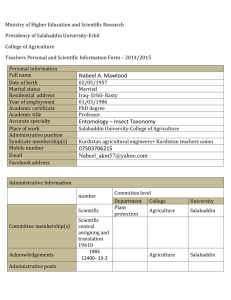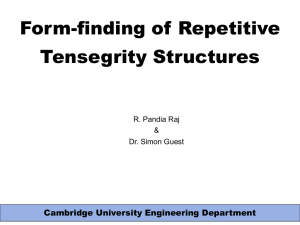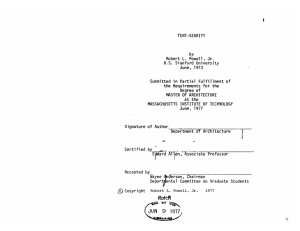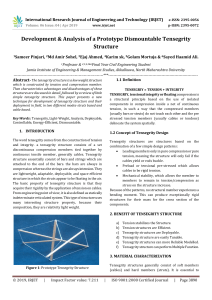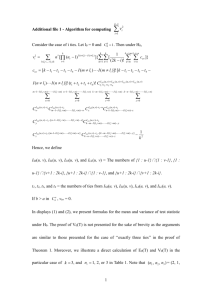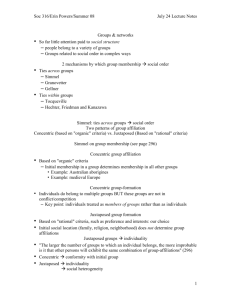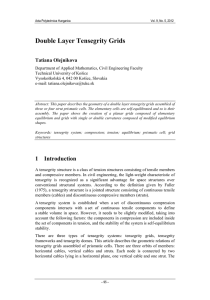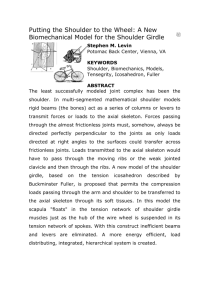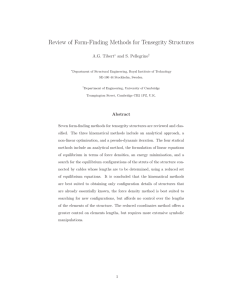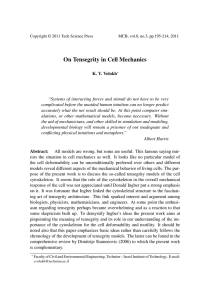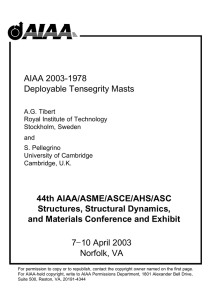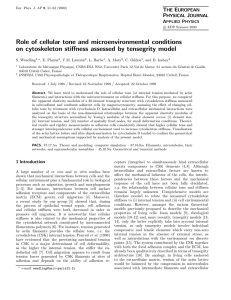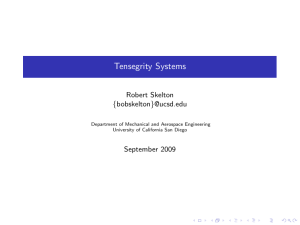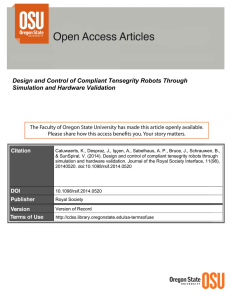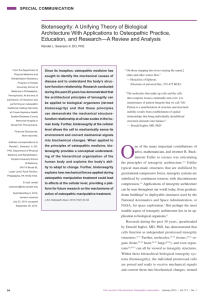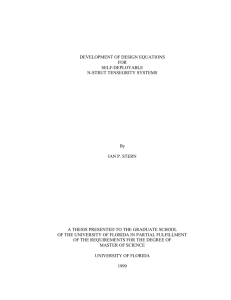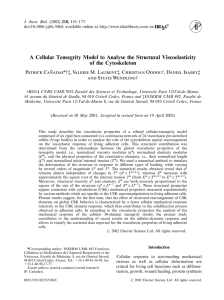Dr.Ibrahim Ismael Hamarash Co-Supervisor: Professor Dr. Carl Crane
advertisement
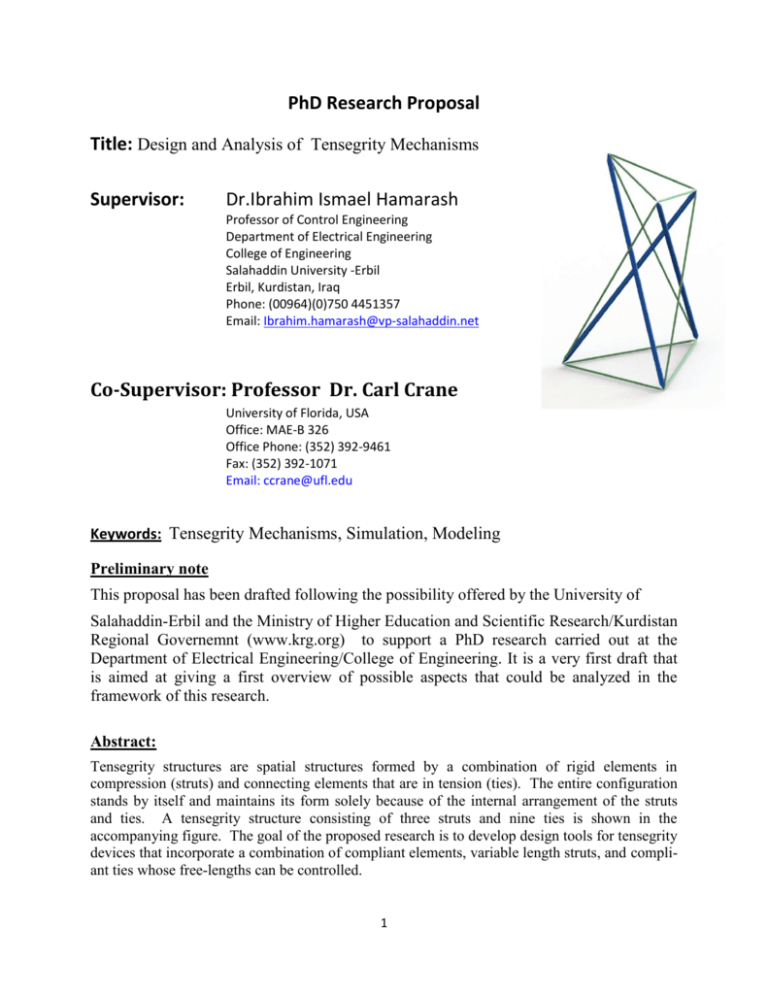
PhD Research Proposal Title: Design and Analysis of Tensegrity Mechanisms Supervisor: Dr.Ibrahim Ismael Hamarash Professor of Control Engineering Department of Electrical Engineering College of Engineering Salahaddin University -Erbil Erbil, Kurdistan, Iraq Phone: (00964)(0)750 4451357 Email: Ibrahim.hamarash@vp-salahaddin.net Co-Supervisor: Professor Dr. Carl Crane University of Florida, USA Office: MAE-B 326 Office Phone: (352) 392-9461 Fax: (352) 392-1071 Email: ccrane@ufl.edu Keywords: Tensegrity Mechanisms, Simulation, Modeling Preliminary note This proposal has been drafted following the possibility offered by the University of Salahaddin-Erbil and the Ministry of Higher Education and Scientific Research/Kurdistan Regional Governemnt (www.krg.org) to support a PhD research carried out at the Department of Electrical Engineering/College of Engineering. It is a very first draft that is aimed at giving a first overview of possible aspects that could be analyzed in the framework of this research. Abstract: Tensegrity structures are spatial structures formed by a combination of rigid elements in compression (struts) and connecting elements that are in tension (ties). The entire configuration stands by itself and maintains its form solely because of the internal arrangement of the struts and ties. A tensegrity structure consisting of three struts and nine ties is shown in the accompanying figure. The goal of the proposed research is to develop design tools for tensegrity devices that incorporate a combination of compliant elements, variable length struts, and compliant ties whose free-lengths can be controlled. 1 Value of the project for the Kurdistan Region Tensegrity structures are relatively new. They have become popular for architectural applications in that the ties, which are in tension, are light weight members. This can reduce construction cost and time. An example where tensegrity principles have been used is for the roof of the Georgia Dome in Atlanta. The roof frame is constructed of rigid struts in compression and ties which are in tension. Tensegrity devices that have compliant (elastic) ties have the additional property that they are self-deploying. The struts shown in the figure can be tied together, and when they are released, they quickly achieve a configuration of minimal potential energy in the compliant ties. One application for this property is the development of self-deploying shelters that can be assembled in a very short time with virtually no tools. The value of the project for the Kurdistan region is the application of this technology to building construction applications. Knowledge of the dynamics of the devices will also lead to the design of structures that can withstand disturbances such as earthquakes and bad storms. A thorough understanding of these devices is the necessary step for their development and application. Research Methodology The analysis of tensegrity structures will be based on the Theory of Screws that was developed by Sir Robert Stawell Ball in his seminal text “A Treatise on the Theory of Screws” published in 1900. Screw theory is based on a firm geometric foundation and can be used to describe systems of forces and torques acting on a body as well as the infinitesimal motion of a body in space.Having described the system mathematically using screw theory, different solution techniques (numerical and symbolic) will be investigated to evaluate the response (motion and deformation) of candidate structure designs under variable loading conditions. Necessary Equipment and Apparatus The primary analysis tools will be the commercial software Maple and Matlab. Academic licenses are available at the University of Florida (UF) and can be loaded on any UF owned computers. The software SolidWorks would also be used to develop computer models of candidate designs. A license for each would have to be acquired for use at Salahaddin University.A prototype will also be fabricated and mechanical components will have to be purchased. Necessary Training Courses Prerequisite knowledge is found in the typical undergraduate courses of statics, dynamics, controls, and C language programming. Specific graduate courses that are offered at UF are EML 6281 and EML 6282, Robot Geometry I and II. These courses provide the needed information in the areas of spatial geometry and screw theory. Several other related graduate courses are available at UF in the areas of controls, analytical dynamics, and structural dynamics. 2 Estimated Budget Travel of UF co-supervisor to Salahaddin University-Erbil. Two one-month visits. Estimated travel cost of $4,000 per trip. Travel of Salahaddin University co-supervisor to UF. Two one-month visits. Estimated travel cost of $4.5,000 per trip. Ph.D. student travel to UF. Two visits total. Estimated travel cost of $3,000 per trip. Ph.D. student two semester study at UF. An estimate of living expenses is $13,000.1Tuition at UF is currently $1,243.20 per graduate credit hour for non-Florida residents2. Nine credit hours are required per semester for a full-time student. Eighteen credits for two semesters of study would cost $22,378. However, this cost can be reduced if the student is eligible for a College of Engineering Achievement Award3 . Under this program, tuition and fees are reduced to $555.00 per credit hour. Eighteen credit hours would then cost $9,990. For planning purposes, the tuition and fee estimate is increased by 15% due to planned tuition increases in the coming year. Prototype materials, $6,000. Eligibility for Achievement Award: Applicants must meet each of the following requirements to be considered for the award: 1. The award is open to out-of-state and international students only. 2. Nominees should intend to enroll for the first time as graduate students within the College of Engineering. 3. Awardees may not receive any additional financial aid, including assistantships, fellowships, and scholarships. Financial support from employment unrelated to the student's degree program is allowed. 4. Grade Point Average or equivalent of at least 3.0, as accepted by the UF Office of Admission. 5. GRE score (Verbal + Quantitative) = 1200, as accepted by the UF Office of Admission office. Alternately, a nominee may present a passing score on the FE exam and 5 years work experience. 1 Living expenses at UF can be obtained at http://www.ufic.ufl.edu/iescosts.htm Fall 2011 UF tuition rates can be obtained http://fa.ufl.edu/ufs/cashiers/2011/fee-tier-ay2011-20118.asp#credit 3 Achievement Award information can be obtained at http://mse.ufl.edu/students/131.html 2 3
